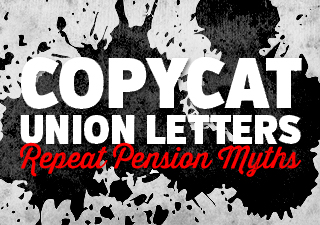Media

Copycat Union Letters Repeat Pension Myths
In July, a commentary by Matt Brouillette on why pension reform failed in our state legislature ran in several newspapers across Pennsylvania. Now response letters from teachers have been published in Erie, Allentown and Harrisburg that repeat myths on the “costs” of reforming our unaffordable pension system.
Here’s the kicker, though: They’re basically all the same letter, with slight stylistic differences. Ironic when educators are supposed to police against plagiarism. But then, each letter has been signed by current local or past union officers of the Pennsylvania State Education Association, a powerful foe of needed reform. Here’s how each letter opens:
The Harrisburg Patriot-News: “The Commonwealth Foundation tries to promote itself as an advocate for fiscal conservatism. So it’s strange that their president Matthew Brouillette actually promotes changes to public employee pensions which would increase costs to Pennsylvania’s taxpayers by at least $42.4 billion over the next 30 or so years.”
The Morning-Call: “Although the Commonwealth Foundation promotes itself as an advocate for fiscal conservatism, its president, Matthew Brouillette, in a Your View actually promotes changes to public employee pensions that would increase costs to Pennsylvania taxpayers by at least $42.4 billion over the next 30 or so years.”
The Erie Times: “The Commonwealth Foundation likes to promote itself as an advocate for fiscal conservatism. But its president, Matthew Brouillette, author of the Guest Voice ‘Big Government Party dooms reforms’ in the Erie Times-News on July 17, actually promotes changes to public employee pensions that would increase costs to Pennsylvania’s taxpayers by at least $42.4 billion over the next 30 or so years.”
More important than the copycat letters, however, is the claims they make. Will switching school teachers and other public employees to a 401(k)-style plan—what the vast majority of private sector businesses have done—actually cost taxpayers more than our current system? The answer is no, and it’s plain to see why.
The estimates of costs are just that: Estimates. Actuaries don’t agree on what the actual costs of a defined benefit plan are, because such plans are based on several assumptions.
For example, officials have assumed that our state plans for school employees and state workers will earn a 7.5 percent return, an estimate that has proven far too optimistic and added billions to our funding shortfall—a gap that taxpayers must now fill. It’s also been assumed that our state legislature would continually and adequately fund the pension plans year to year, another assumption that’s been proven wrong.
By contrast, defined contribution plans have completely predictable costs with no unfunded liability, because pension benefits must be funded as they’re earned. Furthermore, if we “let Act 120 work,” assuming both the unlikely 7.5 percent return and that lawmakers make payments on schedule, then taxpayers will pay $212.4 billion in pension costs over the next 30 years.
That’s the real crisis facing taxpayers and teachers alike—not the supposed costs of fixing the system for our future.